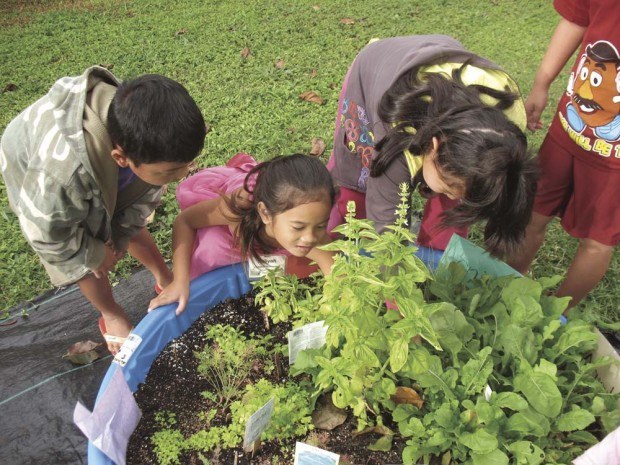LIHU‘E — Wilcox Elementary School kindergartners are working on their gardens and learning through interactive lessons. The gardens are made from kiddie pools with holes drilled in the bottoms for drainage. A lava rock layer is made. Then comes the
LIHU‘E — Wilcox Elementary School kindergartners are working on their gardens and learning through interactive lessons.
The gardens are made from kiddie pools with holes drilled in the bottoms for drainage. A lava rock layer is made. Then comes the garden soil.
The children are now planting. They made signs to show what kind of plants they planted and to remember what was planted where. Some classes planted seeds directly. Some classes made starts . To make starts, they planted seeds in small cups and containers. When the plant was big enough, they transplanted the small plants into the pool garden.
Most of the nine kindergarten classes can see their gardens from their classroom windows. This is important for the children to do daily observations of their gardens.
The children water daily and they write in their journals. The kindergarten teachers have noticed improvements with this project.
The children come into the classroom, put their things down and then ask if they can go look at the garden, first thing in the morning.
Their writing has more depth of feeling in relation to this project. They write things like, “Please, please, why won’t my seed sprout?” and “Wow, that plant got so big this weekend!”
They ask questions about bugs, growth patterns, time, watering, the energy of the sun and much more.
If their families have gardens, the children often enjoy sharing about what they know. If they are in homes with no gardens, they often are even more fascinated with growing plants.
They have learned more patience, scientific observation, the flow of matter and energy, and some agricultural technology, along with biology. This also leads into discussions on nutrition and health, and just plain old ono food.
When the children harvested arugula in one kindergarten class, there was enough for each child to take home one bag a piece! The children were proud of this dark, leafy green they had grown. Besides arugula, there is mustard, basil, dill, Chinese parsley (cilantro), green beans, Thai basil, catnip, green onion and other herbs in the gardens.
Harvesting will continue with the herbs being shared between families and The Loaves and Fishes Food Bank across from Wilcox School. An herbal cookbook is being made by the teachers and parents and is anticipated for sale by May Day.
The nine kindergarten teachers will hana hou next school year with their gardens and these valuable interactive lessons.
One of the teachers this year also grew a pumpkin next to the pool gardens. The children measured the amazing growth every day the last month and learned about squash growth, centimeters and inches.
The 5th grade Hydroponics Club helped to put down weed cloth under the gardens. They also drilled the holes, put in the lava rocks, then the garden soil. They positioned the pool gardens the way the teachers requested. Mahalo to Mr. Yoshi and the Hydroponics Club for their kokua!
This project was made possible by a generous grant — written by Linda Sciaroni, a wonderful science teacher and parent — from the state farm Youth Advisory Board. It is only one level of the goal of this grant, for sustainable growing, financial literacy and community service at Wilcox Elementary School.
• Natalie Joyce-Maeda is a grant coordinator at Wilcox School.




